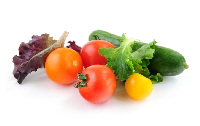Vegetables
Planning Your Vegetable Garden
When deciding where to plant your vegetable garden, choose the best available location by keeping the following factors in mind.
Good soil. You may have little choice concerning the soil type available to you, but you can use a simple test to find out whether your soil is in good condition for planting. Squeeze a handful of soil to test for moisture content. If the squeezed soil forms a clump, the soil is too wet to work. If you work soil that contains this much moisture, it might form into hard, cement-like clumps, which can cause problems for the remainder of the year. If the soil crumbles easily when it is squeezed, it is in an ideal condition to work. Correct tillage and the use of good organic and soil amendments can improve poor soil and can increase yield, even in good soil. Raised beds help improve drainage and tend to warm up sooner in the spring.
Light Most vegetables need at least 8 hours of light a day. Position your vegetable plot away from large trees that could shade the area part of the day.
Level ground is best for growing vegetables. It is easier to prepare, plant, and irrigate than sloing ground. If you must plant on sloping ground, run rows across the slope, not up and down, to keep the soil from washing away during irrigation.
Water supply. Locate your garden near an abundant supply of water easily reached with a garden hose. Adequate light. Vegetables need at least 8 hours of sunlight each day for best growth. Plant vegetables where they are not shaded by trees, shrubs, walls, or fences. Trees and shrubs also compete with vegetables for the water available in the soil. If your garden is large enough for you to use power tools, be sure you have easy access to a road or driveway wide enough for equipment movement.



